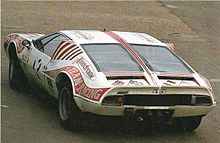De Tomaso Mangusta
| De Tomaso | |
|---|---|
|
De Tomaso Mangusta
|
|
| Mangusta | |
| Production period: | 1967-1971 |
| Class : | Sports car |
| Body versions : | Coupe |
| Engines: |
Otto engine : 4.7 liters (224 kW) |
| Length: | 4275 mm |
| Width: | 1830 mm |
| Height: | 1100 mm |
| Wheelbase : | 2500 mm |
| Empty weight : | 1385 kg |
| Previous model | De Tomaso Vallelunga |
| successor | De Tomaso Pantera |
The De Tomaso Mangusta was a sports car made by the Italian manufacturer De Tomaso .
Development history
De Tomaso's Mangusta was - like most De Tomasos of the 1960s - a difficult birth, which was due to Carroll Shelby and the car maker Ghia . De Tomaso experimented with a sports car with a central tube frame on a Ford V8 basis for Carroll Shelby. That was the 70P with a 5.7 liter engine, the engine should be in the middle and be connected to a ZF gearbox . At the same time, Giorgetto Giugiaro, then chief designer at Ghia, designed a sensational body for Piero Rivolta at Iso. Both projects were abandoned in 1966.
However, designer De Tomaso later brought the two concepts together. He designed a mid-engine coupé with the chassis of the Vallelunga, which was reinforced a little, with a slightly modified Ghia body and a 4.7-liter version of the US Ford engine - and the Mangusta was finished. "Mangusta" is the Italian word for the mongoose - a small mammal that is able to defeat poisonous cobras. The name "Mangusta" signaled that this car should be a serious competitor for Carroll Shelby's Cobra .
The first prototype had a fiberglass body in 1966, but when the Mangusta went into production a year later it was built with a Ghia body made from a steel frame with aluminum planking. Technically and optically it looked like a typical Italian sports car, but it was a tamed racing car. The bonnet was divided, it consisted of two wing doors with the rear windows opening lengthways to the direction of travel. The engine could be seen underneath. The weight distribution was far from good (68% was on the rear axle), it had a narrow passenger compartment that was very heated by the engine, and the windshield was very close to the driver. As with the Vallelunga, the central tubular frame of the Mangusta also seemed to be too soft, and the handling was problematic, but the driving performance was undisputed.
The body is worth a look, for example the tailgate, which is split lengthways in the middle, acts as a wing door. Constructed with great attention to detail and good workmanship, the Mangusta could have been a sensation back then. But the way it was sold, it was almost uncontrollable in the wet and uncomfortably light at the front at high speeds.
Only 400 Mangustas were built in the four years of production.
The second edition
Another car called De Tomaso Mangusta was built between 1996 and 2002. This was a new development from De Tomaso, which was presented in 1995 under the name Biguà. De Tomaso sold the rights to the vehicle to Kjell Qvale, who from 1999 produced the car in his own plant in Modena . It was thanks to a clever move by Alejandro de Tomaso that the car could not be sold as De Tomaso Mangusta: Qvale had acquired the rights to the construction and the name Mangusta, but not the rights to use the name De Tomaso. In the following years the car was therefore sold as Qvale Mangusta , an unknown, unattractive name that was responsible for the economic failure of the vehicle to a not inconsiderable extent.


